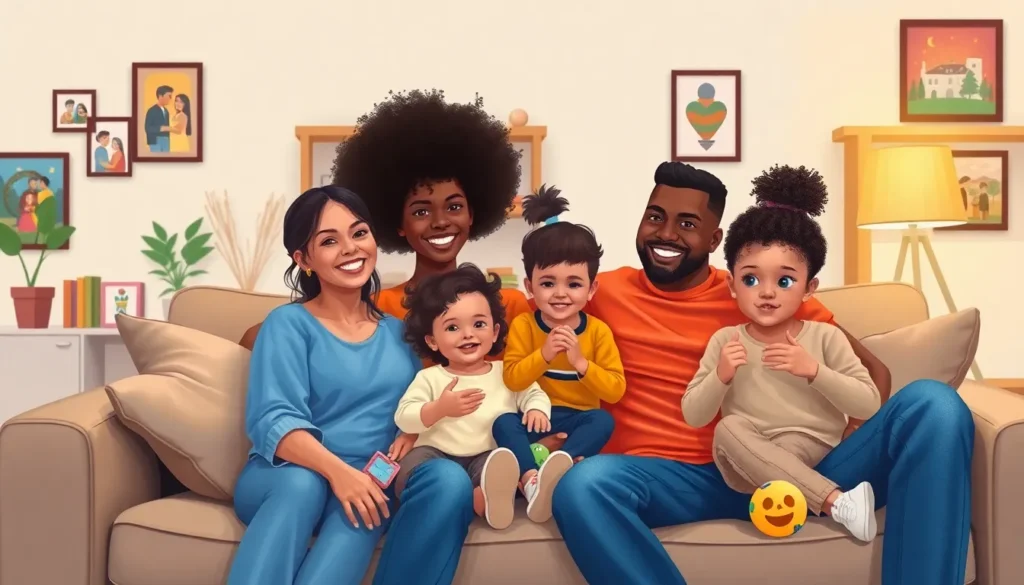Table of Contents
ToggleThe decision to give a child up for adoption can feel like navigating a maze blindfolded. It’s a journey filled with emotions, uncertainties, and a sprinkle of guilt—like trying to choose between chocolate cake and carrot sticks at a birthday party. But sometimes, making the hardest choice can lead to the brightest future for both parent and child.
Adoption isn’t just about saying goodbye; it’s about opening doors to new possibilities. It’s a chance to find a loving family who can provide what might not be possible right now. With the right information and support, this can transform into a heartfelt story of love and hope. So, buckle up and let’s explore the ins and outs of this life-changing decision, ensuring it’s as smooth as a well-buttered slide on a sunny day.
Understanding Adoption
Adoption represents a significant legal and emotional process. It entails the transfer of parental rights from biological parents to adoptive parents. Many view adoption as a way to provide children with loving homes.
Parents considering adoption often face complex emotions. Feelings of loss may coexist with hope for their child’s future. Understanding these emotions is crucial for anyone involved in the adoption process.
Types of adoption exist to accommodate various needs. Open adoption allows for ongoing contact between birth parents and adoptive families. Closed adoption restricts such communication. Each type presents distinct benefits and challenges, which parents should carefully consider.
Legal requirements vary by state, affecting the adoption journey. Prospective adoptive parents typically undergo background checks and home studies. These measures ensure a safe environment for the child.
Choosing adoption involves exploring resources and support networks. Organizations like the American Adoption Congress provide valuable insights. Many also seek guidance from adoption counselors to navigate emotions.
The importance of informed decision-making cannot be overstated. Resources should include legal assistance, support groups, and educational materials. All available options must align with the values and wishes of the birth parents.
Ultimately, understanding adoption leads to positive outcomes for all parties. Clarity around processes and expectations fosters confidence in decision-making. Adoption has the potential to change lives, offering children a chance for stability and embracing new beginnings.
Reasons For Giving A Child Up For Adoption
The decision to give a child up for adoption often stems from various factors that affect the biological parent or parents. Understanding these reasons is essential for a comprehensive perspective on the adoption process.
Personal Circumstances
Personal circumstances frequently play a pivotal role in the decision to pursue adoption. Financial instability can create significant challenges, making it difficult for a parent to provide adequate care. Additionally, health issues may impede a parent’s ability to nurture a child properly. For some, the timing of parenthood may not align with personal goals, such as education or career aspirations. Relationship dynamics can further complicate the situation, especially if parents face challenges in their partnerships or single parenting. Ultimately, these personal factors contribute to the desire for a more secure future for the child through adoption.
Societal Pressures
Societal pressures can heavily influence the choice to place a child for adoption. Stigma surrounding unplanned pregnancies often prompts feelings of shame or fear. Expectations from family, friends, or community can create immense pressure to conform to specific ideals regarding parenting. Many individuals feel overwhelmed by the perception of what it means to be a ‘good parent’ in society’s eyes. These external pressures may lead a parent to conclude that adoption offers the best solution for both themselves and their child. Recognizing these societal influences is essential when discussing the emotional complexity of the adoption decision.
The Adoption Process
The adoption process involves several structured steps that ensure a safe transition for the child. Understanding the legal and procedural components is crucial for prospective adoptive parents.
Legal Requirements
Legal requirements vary by state and play a vital role in the adoption process. Every state mandates a home study to assess the suitability of the adoptive family. Background checks are also required to ensure the child’s safety. Parental rights must be legally relinquished before adoption can proceed. Biological parents often need to provide consent, which involves specific legal documentation. Additionally, some states require counseling or waiting periods to ensure informed decision-making. Compliance with these regulations safeguards both the child’s and adoptive parents’ interests.
Choosing An Adoption Agency
Choosing an adoption agency significantly affects the adoption experience. Researching agencies helps identify those that align with personal values and preferences. Some agencies specialize in open adoption, while others focus on closed arrangements. Prospective parents should consider the agency’s reputation, success rates, and available resources. Meeting with agency representatives can clarify their services and support systems. Evaluating different options ensures finding an agency that prioritizes the well-being of both child and birth parents.
Emotional Impact
Deciding to give a child up for adoption brings profound emotional challenges. Parents often navigate a complex mix of feelings, shaping their perspectives throughout the process.
Feelings Of Loss
Loss permeates the adoption experience. Parents regularly confront deep sorrow upon parting with their child. Emotional ties complicate the situation, creating a sense of grief similar to losing a loved one. Many parents grapple with memories of their child’s early moments, intensifying the heartache felt with each step in the adoption process. Recognizing and processing these feelings fosters healing. Support from professionals and loved ones becomes crucial, as it aids in understanding that grieving is a normal part of letting go.
Potential For Regret
Regret often shadows the decision to place a child for adoption. Parents might question if they made the right choice, especially during challenging moments later in life. Facing societal stigma can amplify these doubts, leading to increased feelings of isolation. Many experience anxiety regarding the child’s well-being, wondering about their future and family. Acknowledging these worries is essential, as it promotes openness and healing. Support networks, including counseling and peer groups, offer a safe space for validating these emotions without judgment, crucial for a more positive adjustment to life post-adoption.
Support Systems
Support systems play a critical role in the adoption journey, providing essential resources and emotional assistance. Counseling services and support groups offer unique avenues for parents navigating this difficult decision.
Counseling Services
Counseling services provide crucial emotional support for parents considering adoption. Trained professionals help individuals process their feelings, offering strategies for coping with grief and loss. Many counselors specialize in adoption-related issues, ensuring they understand the complexities of the transition. Parents can also explore therapeutic sessions that encourage healthy communication and reflection. Seeking out these services promotes emotional well-being, helping parents gain clarity about their choices and the future.
Support Groups
Support groups create a sense of community among individuals faced with similar experiences. Parents can share their stories, fostering understanding and compassion. Many organizations host regular meetings, both in-person and online, to accommodate various schedules. Connections built in these groups often lead to lasting friendships. Members share resources, helpful tips, and emotional encouragement, making the journey feel less isolating. Engaging in a support group allows parents to express their thoughts in a safe environment, promoting healing and acceptance.
Deciding to give a child up for adoption is a deeply personal journey filled with complex emotions. While it may be a painful choice, it can also open doors to new opportunities for both the parent and child. Understanding the emotional landscape and seeking support can make this process more manageable.
Adoption isn’t just an end; it’s a chance for a fresh start. By navigating the legal requirements and exploring various adoption types, parents can find the best path forward. With the right resources and support, they can embrace this decision with hope for a brighter future.










